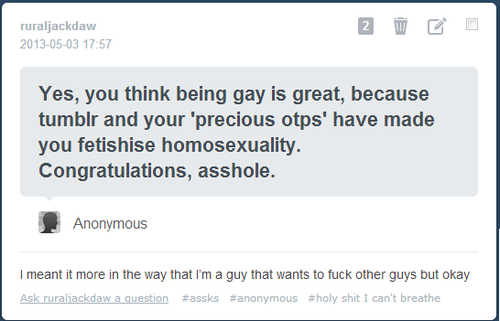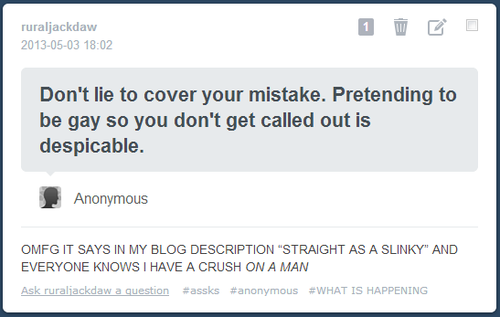Charissa Cotrill's Blog, page 77
May 5, 2013
odditiesoflife:
Pando - The Single Largest Living Organism on...


Pando - The Single Largest Living Organism on Earth
Pando or The Trembling Giant is an enormous grove of Quaking Aspen that is an entire forest out of a single organism. This colony of a single male Quaking Aspen is located in the Fishlake National Forest in Utah, in the US. Each of 47,000 or so trees in the grove are genetically identical and has been determined to be part of a single living organism all sharing a single massive underground root system. Pando is truly massive – it covers an area of 43 hectares, weighs 6,000 tons and is more than 80,000 years old.
thepeoplesrecord:
Every 28 hours an African American is...
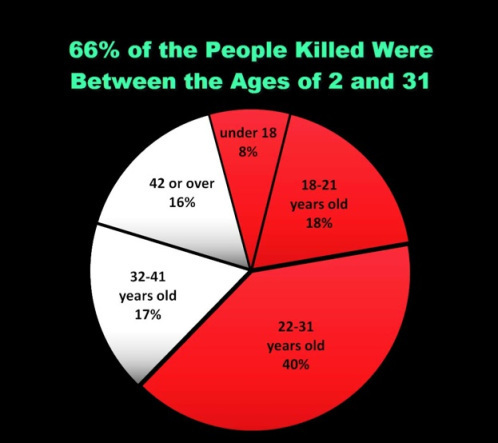
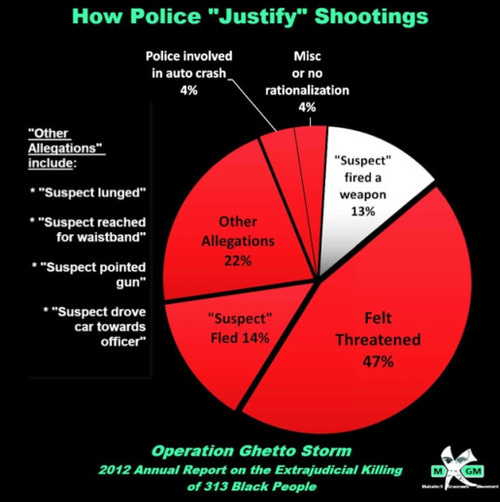
Every 28 hours an African American is extrajudicially executed in the U.S.
April 24, 2013Every 28 hours a black woman, man or child in the United States is executed by a person employed or protected by the US government according to a year-long investigation by the Malcolm X Grassroots Movement (MXGM), which has thus far been virtually ignored by the news media, progressive outlets included.
Following the murder of Trayvon Martin, the MXGM embarked on a year-long study to determine the prevalence of extrajudicial killings of black Americans. The organization initially recorded around 120 killings in the first half of 2012, which came out to one black person murdered every 36 hours. That number climbed to 313 by the end of last year, forcing the MXGM to update its findings to every 28 hours in their latest report, titled “Operation Ghetto Storm“. That’s almost one black American killed every day by law enforcement, security guards and/or vigilantes, which the MXGM believes is more accurate since their numbers reflect only those killings that are reported by police departments and the news media. As the organization points out in the report, there exists no national tracking of police-involved shootings, so it’s impossible to know the full extent of the crisis.
The Numbers
The largest portion of those killed in 2012 (40 percent) were between the ages of 22 to 31, followed by 18 to 21 year olds at 18 percent. Children made up 8 percent of extrajudicially executed black Americans.
Furthermore, 44 percent of those killed were unarmed while 27 percent were “allegedly” armed, meaning police claimed the victim was armed but no corroborating evidence existed to prove this was the case. Only 13 percent of those killed were said to have “fired a weapon either before or during the officer’s arrival”, according to the MXGM.
One of the report’s most damning findings is the sheer lack of accountability for these killings. Thus far, less than 9 percent of those responsible for the deaths have faced charges, almost all of whom are security guards or vigilantees and all of which have yet to be determined. Despite the fact that an overwhelming number of the victims were definitively unarmed, only 3 percent of officers officers responsible for the deaths have been charged: “3 for vehicular crimes stemming from their crashes, 5 for manslaughter—the killers of Remarley Graham, Wendell Allen, Dane Garrett Scott Jr, Christopher Brown, and Bobby Moore Jr.”
And the justifications are almost always the same: “I felt threatened”, “he reached for his waistband to get what I thought was a gun”, “he was acting suspiciously”, etc. All are based on personal perceptions that are no doubt influenced by racial stereotypes, given that every American is surrounded by a culture that conditions them to fear the “criminal black man”.
This isn’t speculation. Study after study has confirmed the lethal consequences of the black-as-criminal stereotype.Source (there is much more text to this article here - check it out)
May 4, 2013
"On Periods: Let’s put this shit to bed right now: Women don’t lose their minds when they have..."
fuckyeahneedlework:
herecomessophie:
Home is where your wifi...
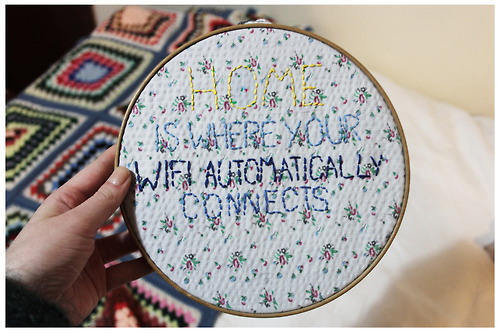
Home is where your wifi automatically connects
SHIT YEAH
I need this on my wall. :D
mattfractionblog:
thumbcramps:
hi guys! this is a comic i made...



hi guys! this is a comic i made for a final in my comics in literature class. we had to do a research paper on a topic we’d discussed in class and then accompany it with a comic with a relevant subject. my paper was about hyper-sexualization of women in comic books, but i decided to broaden it out here as well as personalize it and make myself the subject and discuss something i’ve been subjected to in the convention circuit and on the internet as well as thousands of other women, as well as give a cue to thought about how the comic book industry as well as the video game industry and even just media in general (all of which are male dominated) push such ridiculous pressures onto girls and women.
also, it feels kind of silly to have to add this since i hope it’s obvious, but i am very aware that there are men that don’t subscribe to this attitude, and am incredibly grateful that these issues are brought to light to people other than the ones that are subjected to it.
anyway haha i have literally been staring at this for 9 hours i don’t even know which direction is up anymore. thanks for reading!!!
Fantastic.
citadelbloodbeard:
swoz:
jadeb0t:
jadeb0t:
people wanted it...

swoz:
people wanted it rebloggable
I’m glad that at least I can make myself laugh
it’s painful how much I didn’t expect this to get this many notes
Here’s one more nerd.
Damn it. I laughed.
citadelbloodbeard:
theolduvaigorge:
Twisting the tale of human...

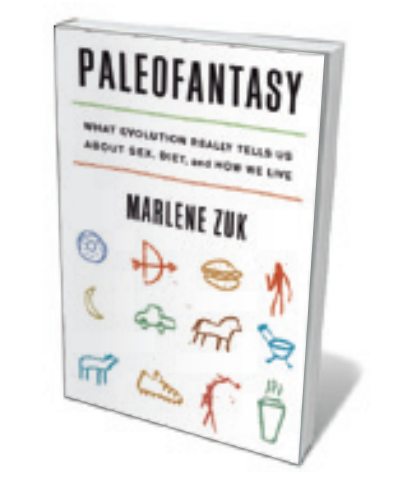
Twisting the tale of human evolution
John Hawks critiques Marlene Zuk’s Paleofantasy“Advances in medicine and psychology may be stunning, but why is humanity plagued with persistent and widespread ills, from diabetes to depression? Some anthropologists and psychologists speculate that an evolutionary mismatch is at work: we are cave-dwellers struggling in a high-tech world. But as Marlene Zuk explains in Paleofantasy, many of these ideas amount to little more than pseudoscience based on an imagined past.
The palaeofantasist’s basic idea is this: natural selection tends to make a population well adapted to its environment. But change the environment enough, and finely tuned adaptations start to fail. Human environments in particular have changed radically in the past 10,000 years, meaning that many human traits may not work well today.
Except, argues Zuk, it is not that simple. Zuk, a biologist, reviews how our assumptions about the past have shaped the science of human biology in relation to factors ranging from exercise and diet to mating and marriage. She ably presents a sceptical and light-hearted view of a long list of palaeofantasies and supposed solutions. (My name appears in the book a few times as a sceptic of various poorly supported hypotheses and as a researcher investigating well supported ones.) For instance, our feet seem well adapted for running, yet stress injuries to feet, legs and backs are rife among runners. Palaeofantasy solution: run barefoot. Some psychologists have argued that humans aren’t meant for monogamy, because our ancestors were supposed to have interacted like the ‘sexually social’ bonobo. Palaeofantasy solution: open marriages.
How do these controversies arise? Because scientists try to reconstruct ancient environments by piecing together archaeological data, comparative primate behaviour and observations on living, small-scale societies such as the Hadza of Tanzania or the Aché of Paraguay that have lifestyles similar to those of our ancestors. But every living and archaeological group has its own distinctive circumstances and history. We can’t blithely assume that we can reconstruct the environment relevant to natural selection in the past.
By presenting the state of evolutionary science, Zuk shows that palaeofantasies cannot be justified across a range of environments or with a range of behaviours. She details the evolutionary analysis of human mating patterns, showing that monogamous mating goes way back. Human childhood is long compared with that of our ape relatives, and the palaeofantasy explanation is that cognitive development necessitates a long childhood. Zuk runs through extensive data on the supply side, establishing the credibility of the alternative hypothesis that humans have maintained high rates of reproduction by reducing maternal energy investment in children, instead recruiting grandparents and other relatives to help care for them.
There are other such examples. Many clear cases of recent adaptation show that natural selection has kept pace with some rapid environmental shifts. For example, malaria has induced dozens of genetic adaptations in tropical peoples during the past few thousand years. And diets in the late Pleistocene epoch, which came to a close about 11,700 years ago, were very diverse; Neanderthals, for instance, noshed on cooked grains. With advances in our understanding of the global human population and the rapidly shifting climates of the most recent glaciation, no single model can encompass this diversity.
There are a few real mismatches among the fake ones Zuk highlights. Diet is one. Pleistocene people did not rely on large stored harvests of starchy grains, fatty meat and milk from domesticated animals, or processed sugars — all of which are among the causes of the obesity, type 2 diabetes and metabolic syndrome that are so prevalent today. Some popular diet regimes attempt to rectify the problem by prescribing a menu modelled on one that probably prevailed before the invention of agriculture 10,000 years ago. But although cutting out starchy grains, sugars and milk, and relying on lean meat has helped many people shift to a healthier lifestyle, it has driven some adherents to extremes.
As an anthropologist, I observe that Zuk’s use of the term ‘fantasy’ is just an emphatic way of describing the hypothesis-forming that is essential to evolutionary science. We play with hypotheses, explore their predictions and try very hard to falsify them. So it is, in a way, unremarkable that so many hypotheses proposed by anthropologists about ancient environments now seem to be wrong — and, in a few cases, even ridiculous.
It means that science is working. Genomics, high-resolution climate records, and microscopic and isotopic evidence have changed our understanding of what the past has to offer. With that in mind, let the next round of palaeofantasies begin”.
John Hawks is associate professor of anthropology at the University of WisconsinMadison, USA, and runs the weblog http://johnhawks.net
(Source: Nature 172(495), 2013)
There’s a lot of misinformation and supposition about what life was like for the first modern humans. Everything from The Flintstones to a Paleo Cleanse diet makes a lot of assumptions about a period in human history that we don’t have a lot of information on.
I ought to check out this book. It looks like a good read.


